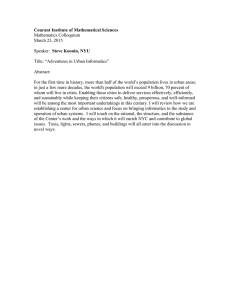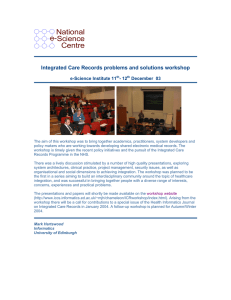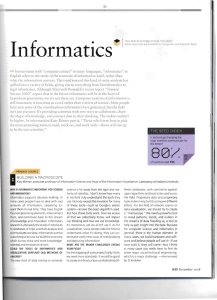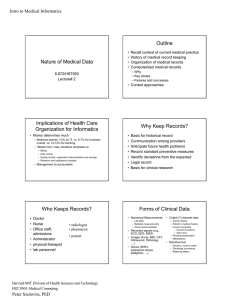Medical Informatics Intro to Medical Informatics
advertisement
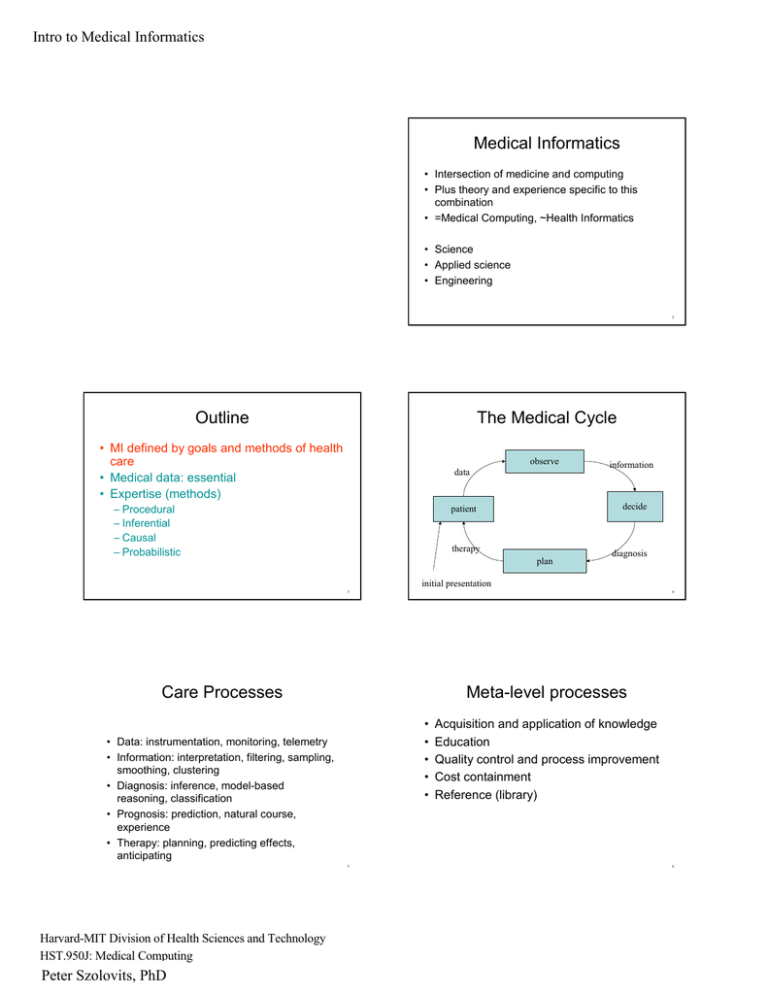
Intro to Medical Informatics Medical Informatics • Intersection of medicine and computing • Plus theory and experience specific to this combination • =Medical Computing, ~Health Informatics • Science • Applied science • Engineering 2 Outline The Medical Cycle • MI defined by goals and methods of health care • Medical data: essential • Expertise (methods) data – Procedural – Inferential – Causal – Probabilistic therapy plan Care Processes diagnosis initial presentation 4 Meta-level processes • Acquisition and application of knowledge • Education • Quality control and process improvement • Cost containment • Reference (library) • Data: instrumentation, monitoring, telemetry • Information: interpretation, filtering, sampling, smoothing, clustering • Diagnosis: inference, model-based reasoning, classification • Prognosis: prediction, natural course, experience • Therapy: planning, predicting effects, anticipating 5 Peter Szolovits, PhD information decide patient 3 Harvard-MIT Division of Health Sciences and Technology�� HST.950J: Medical Computing�� observe 6 Intro to Medical Informatics WHO Constitution defines “health” Time scale in medicine • • • • Cure—usually acute illness Manage—long-term, chronic illness Prevent Predict (especially based on genetics) “a state of complete physical, mental and social well-being and not merely the absence of disease or infirmity” • Physical • Mental • Social —very hard to measure 7 Distribution of Ages 8 Life table death rates by age • Life table deaths by year (Japan, 1989) 9 Life table cohort survival 10 Measures of Health • Longevity at birth (CIA World Fact Book, 2001) US SSA 199711 12 Intro to Medical Informatics Causes of death Quality of life (industrialized countries, 1989) Circulatory system 48% Malignant neoplasms 19% Accidents 7% Others 26% • Value of a total life depends on –Length (assume now is N) –Quality (q) over time –Discounts (� g) for future or past (depends very much on what the value is to be used for) VN=Integral[t=0,T] q(t) g(t-N) dt 13 14 Top 10 Chronic Conditions Persons aged � 65 Modeling life quality 15 Societal quality of life • Aggregation of individual qualities + Equity (distributions) • Is more better? (Population control.) • Is less better? • How much to spend? 17 U.S. Nat’l Ctr Health Stat, Vital and Health Statistics, 1985 (1982 data) 16 Intro to Medical Informatics Changing Context of Health Care Aggregation • Trend: social aggregation leads to decisions at a larger scale • Fee-for-service • HCFA (Health Care Financing Agency) pays for Medicare • Capitation – Multi-specialty providers – Government guarantees and mandates – Risk sharing – Oregon-wide spending “optimization”; – British NHS – HMO’s (Health Maintenance Organizations) take overall responsibility to care for patient for fixed fee – Pushing risk down to the physician or group 19 20 Exponentially growing expense of health care Determining Factors: $£€¥R • More healthcare than steel in GM cars • Increased demand – Much more possible – Better tests, therapies – High human motivation • No pushback • Waste – Unnecessary procedures • ½ of health expenses in last year of life – Marginally useful procedures • Defensive medicine – Bad Medicine 21 Managed Care Controlling Costs and Changing Patient Care IOM, 1989 23 22
